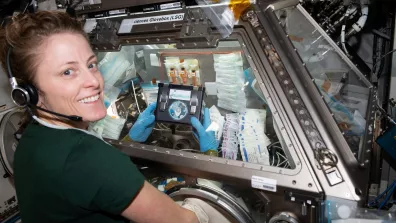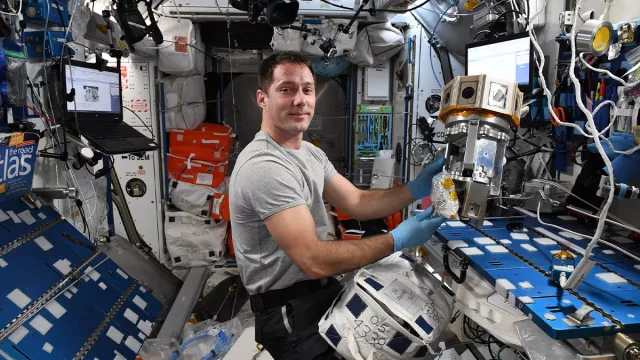Alpha marked French astronaut Thomas Pesquet’s second mission on the International Space Station (ISS). During his six-month stay, for Expeditions 64 and 65, he performed more than 200 scientific experiments and four extravehicular activities.
Unlike his first space mission, Proxima, on which the flight to the ISS was aboard a Soyuz vehicle, this time he flew on a SpaceX Crew Dragon.
Key information
Key figures
- 4 extravehicular activities
- 232 scientific experiments performed by Thomas Pesquet during the mission, 12 of them prepared specially by CNES / CADMOS
- 3,000 revolutions around Earth during the Alpha mission (and as many sunrises and sunsets)
- 396 days spent by Thomas Pesquet in space (Proxima + Alpha missions), making him the European record holder
Key milestones
- 9 November 2021: Landing at 4:33 CET aboard Crew Dragon Endeavour
- 8 November 2021: Separation from ISS at 20:05 CET of Crew Dragon Endeavour
- 12 September 2021: 16, 20 and 25 June 2021: 16, 20 et 25 juin 2021: 4 extravehicular activities
- 24 April 2021: Docking to ISS at 11:00 CET
- 23 April 2021: Lift-off at 11:49 CET aboard Crew Dragon Endeavour
Project in brief
Alpha marked French astronaut Thomas Pesquet’s second mission on the International Space Station (ISS). The name was taken from Alpha Centauri, the nearest known star system, consisting of three stars and lying a little more than four light-years from our solar system.
Thomas flew to the ISS on 24 April 2021 aboard a Crew Dragon Endeavour space capsule atop a Falcon 9 launcher (SpaceX – NASA), with crewmates Shane Kimbrough (NASA), Megan McArthur (NASA) and Akihiko Hoshide (JAXA).
The mission’s goals were mainly scientific. In Thomas’ own words: “Every day is different. We have so many experiments to do that it’s hard to remember them all. One day, we might be incubating stem cells and launching nanosatellites in the morning, and then in the afternoon inserting new cartridges in the metals oven designed to enhance alloys. It’s fascinating! I just love doing this work for research scientists that benefits everyone on Earth.”
The experiments covered a broad spectrum of research disciplines, from biology and biotechnologies to medicine and physics, as well as testing of technology demonstrators like for example CNES’s Pilote experiment, which employs virtual reality to explore new ways of providing tactile and visual assistance to astronauts performing robotic operations, or Telemaque, which aims to precisely handle small objects hands-free with ultrasonic tweezers.
Besides all these experiments aboard the station, Thomas Pesquet also accomplished four extravehicular activities.
On 16, 20 and 25 June 2021, the main task for Thomas and Shane Kimbrough (NASA) was to install and deploy new solar panels. Their three EVAs totalled 20 hours and 30 minutes working in space.
On his last EVA on 12 September 2021 to ready the station for the installation of future solar panels, this time accompanied by Akihiro Hoshide (JAXA), Thomas Pesquet set a new total spacewalk record for a European astronaut—all missions included—of 39 hours and 54 minutes.
Obviously, Thomas didn’t spend all his time working on science. He also had plenty of station maintenance tasks (upgraded the ventilation system, installing new toilets, repairing the exercise bike, maintaining the treadmill, etc.) and educational activities (link-ups with primary and secondary school classes and students, or setting up AstroPi microcomputers to enable youngsters to run their programs in space, social media sharing ) to keep him occupied.
On 4 October 2021, Thomas Pesquet became the first French commander of the ISS, taking over from his Japanese crewmate Akihiko Hoshide. He retained this role to the end of his mission, handing over to Russian astronaut Anton Shkaplerov just before returning to Earth.
CNES’s role
For CNES’s contribution to the Alpha mission, the agency’s CADMOS centre for the development of microgravity applications and space operations prepped a dozen scientific, technological and educational experiments. Such experiments seek notably to enhance the ISS as a cutting-edge laboratory, giving scientists the best possible tools to advance science in space, for Earth. The aim is also to support French scientific research and technological advances with an eye on exploration of the solar system and crewed deep space missions.
Experiments conducted for Alpha:
Dreams: Thomas Pesquet wore a sleep headband for several nights fitted with an electroencephalogram sensor using dry electrodes to observe how he adapted and how his sleep patterns changed.
Partners: Toulouse Hospital – Dreem
Cerebral Ageing: To study how brain nerve cells age at molecular level. The ISS offers a unique environment for observing cellular ageing and the impact of radiation on the human body.
Partners: Institut Pasteur – Sup’Biotech – BioServe
Pilote: To test a visual and tactile method for assisting astronauts with robotic tasks, using an immersive virtual-reality headset combined with a haptic force-feedback device to reproduce the senses of pressure and touch.
Partners: Paris University – Tecnalia – CNRS – Oculus
Immersive Exercise: Astronauts’ daily exercise routine in the same closed environment soon becomes repetitive and they gradually get bored with it. The aim of Immersive Exercise is to break this routine with virtual reality. A selection of 360-degree videos filmed on Earth are played in the virtual-reality headset and synchronized with the pedalling speed
Partners: Fit immersion – Oculus – DAC (Danish Aerospace Company)
Telemaque: The experiment employs “acoustic tweezers” designed to hold, move and study objects and liquids without ever touching them. They emit ultrasound waves that exert a force on objects in their path. The acoustic field is shaped in such a way that these objects are trapped. By moving the beam, it is thus possible to move an object with a very high degree of precision.
Partners: Institut Jean Le Rond d’Alembert (Sorbonne University/CNRS) – EREMS – COMAT
Lumina is an optical-fibre dosimeter designed to demonstrate the reliability of this technology for measuring ionizing radiation inside the ISS.
Partners: Hubert Curien Laboratory (Jean Monnet St Etienne University/CNRS) – iXblue – CERN
All experiments flown to the ISS are carried inside a fireproof bag with inner walls made of protective packing foam.
Renewable Foam and Edible Foam employ carry bag packing material designed to replace traditional petroleum-based foams, which are of no further use once aboard the station.
Freshness Packaging, devised by CNES and its partners at NASA’s Food Lab to demonstrate the effectiveness of new types of permeable packaging that allow gas exchanges to extend the shelf life of fruit and vegetables for two to four weeks.
Partners: Groupe Jean Hénaff – ComposiTIC – Innovons à 360° – Maison Pillon – Maison Darnis
TetrISS: This student experiment to visualize ultrasounds is a technology demonstrator of a platform that operates almost autonomously. To validate it, the Chladni Pattern experiment makes fine particles vibrate and observes the standing ultrasound waves thus generated in 3D.
Partners: Tetr’ISS Team – Toulouse IUT technology institute
Eklosion: A student project aiming to symbolize what ties astronauts to Earth by tending to a plant.
Partners: Eklo non-profit association – Faculty of Health, Toulouse-III Paul Sabatier University (ex-GSBMS) – Nantes-Atlantique Design School – Toulouse-III Paul Sabatier University
Blob: To observe how microgravity affects the feeding, behaviour and speed of movement of several blobs placed inside sealed transparent Petri dishes on the ISS and filmed as they feed and explore their environment (Blob-ISS).
At the same time, pupils at more than 2,000 selected schools in France were invited to replicate the experiment in the classroom on Earth (Blob-Earth) and compare how their blobs behaved with those in space.
Partners: CNRS – COMAT – Toulouse education authority – Ministry of Education, Youth and Sport
For more detail about the experiments, see https://cnes.fr/en/projects/mission-alpha
CNES contact
Alpha mission project leader, CNES
Rémi Canton
E-mail: remi.canton at cnes.fr
Project news



